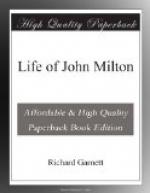The next publication of Milton’s is another instance of the dependence of his intellectual workings upon the course of events outside him. We owe the “Areopagitica,” not to the lonely overflowings of his soul, or even to the disinterested observation of public affairs, but to the real jeopardy he had incurred by his neglect to get his books licensed. The Long Parliament had found itself, in 1643, with respect to the Press, very much in the position of Lord Canning’s government in India at the time of the Mutiny. It marks the progress of public opinion that, whereas the Indian Government only ventured to take power to prevent inopportune publication with many apologies, and as a temporary measure, the Parliament assumed it as self-evident that “forged, scandalous, seditious, libellous, and unlicensed papers, pamphlets, and books” had no right to exist, and should be nipped in the bud by the appointment of licensers. Twelve London ministers, therefore, were nominated to license books in divinity, which was equivalent to enacting that nothing contrary to Presbyterian orthodoxy should be published in England.[2] Other departments, not forgetting poetry and fiction, were similarly provided for. The ordinance is dated June 14, 1643. Milton had always contemned the licensing regulations previously existing, and within a month his brain was busy with speculations which no reverend licenser could have been expected to confirm with an imprimatur. About August 1st the “Doctrine and Discipline of Divorce” appeared, with no recognition of or from a licenser; and the second edition, published in the following February, equally infringed the Parliamentary ordinance. No notice appears to have been taken until the election of a new Master of the Stationers’ Company, about the middle of 1644. The Company had an interest in the enforcement of the ordinance, which was aimed at piracy as well as sedition and heresy; and whether for this reason, or at the instigation of Milton’s adversaries, they (August 24th) petitioned Parliament to call him to account. The matter was referred to a committee, but more urgent business thrust it out of sight. Milton, nevertheless, had received his marching orders, and on November 24, 1644, appeared “Areopagitica; a Speech for the Liberty of Unlicensed Printing”: itself unlicensed.




